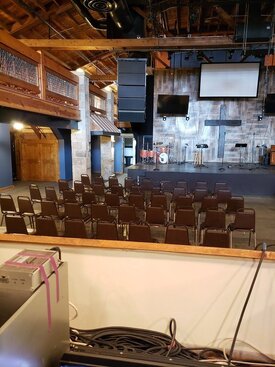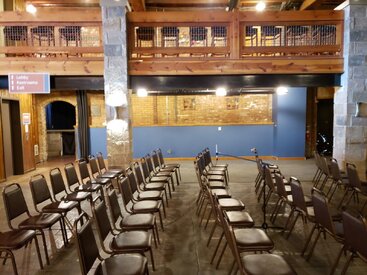Cheyenne Meyer
Registered
Thread Starter
- Joined
- Feb 10, 2019
- Posts
- 6
This is my first post here and I am new to using REW.
I have inherited the responsibilities of "sound coordinator" at my church and I have tasked myself with finding ways to improve the overall quality of the sound (where possible). I thought an easy place to start would be fixing the main EQ on our system. My contention being that the EQ has been set flat except for the low end which has been tapered off at the lowest frequencies. I have found that most of the engineers that mix on our board have a tendency to eq the signal sources with a boost in the mid to high range. I know we have some "trouble" frequencies that present themselves
I purchased a Dayton reference mic and setup our system to use REW and took the following sample at a seat in the sanctuary which was directly on axis with our line arrays and about half way from the front row of seating.


My initial take away:
The high ends definitely roll off precipitously after 1kHz (by almost -14dB by the time it flattens at 12kHz). In fact I was surprised by just how non-linear the system really is. Also, the low end on the crossover has too much gain.
A few notes about our setup:
I'm running REW on a laptop using an ASIO driver to communicate over USB to our digital mixer, an A&H SQ-6. The mains out from the mixer is fed to an analog stereo EQ (Ashly GQX-3102) which is then passed to an analog stereo crossover (a dbx, we used to have a DSP for the line arrays but it recently died on us).
The line arrays are self-powered TCS audio TL1200 cabinets, 5 on the left and 5 on the right. These are 3-way, full range, tri-amped cabinets. They are rated +/- 3dB at ~60Hz to 18kHz. There is a additional single center cabinet fill that is currently unused. Our old mixer was setup for LCR but I've had issues getting it to do anything other than be a source of feedback.
Under the stage are four TCS audio TL1200S subwoofers. These are rate +/- 3dB at ~30Hz to 120Hz. They are powered by four Carvin Audio DCM2000L amps.
The questions for those who are willing to reply:
1. What are your initial thoughts on the frequency response graph?
2. What could be causing the roll off at 1kHz? Is this likely related to the size of the room? Is the reference mic in a bad location?
3. When we replace the temporary dbx crossover with a new DSP, what is the best way to 'EQ' the system? We will likely be going back to having a separate signal feed for the top two cabinets, the middle cabinet, and the bottom two cabinets. Should I test these individually?
4. What other information can I provide that is of use?
Thanks for any replies in advance!
I have inherited the responsibilities of "sound coordinator" at my church and I have tasked myself with finding ways to improve the overall quality of the sound (where possible). I thought an easy place to start would be fixing the main EQ on our system. My contention being that the EQ has been set flat except for the low end which has been tapered off at the lowest frequencies. I have found that most of the engineers that mix on our board have a tendency to eq the signal sources with a boost in the mid to high range. I know we have some "trouble" frequencies that present themselves
I purchased a Dayton reference mic and setup our system to use REW and took the following sample at a seat in the sanctuary which was directly on axis with our line arrays and about half way from the front row of seating.
My initial take away:
The high ends definitely roll off precipitously after 1kHz (by almost -14dB by the time it flattens at 12kHz). In fact I was surprised by just how non-linear the system really is. Also, the low end on the crossover has too much gain.
A few notes about our setup:
I'm running REW on a laptop using an ASIO driver to communicate over USB to our digital mixer, an A&H SQ-6. The mains out from the mixer is fed to an analog stereo EQ (Ashly GQX-3102) which is then passed to an analog stereo crossover (a dbx, we used to have a DSP for the line arrays but it recently died on us).
The line arrays are self-powered TCS audio TL1200 cabinets, 5 on the left and 5 on the right. These are 3-way, full range, tri-amped cabinets. They are rated +/- 3dB at ~60Hz to 18kHz. There is a additional single center cabinet fill that is currently unused. Our old mixer was setup for LCR but I've had issues getting it to do anything other than be a source of feedback.
Under the stage are four TCS audio TL1200S subwoofers. These are rate +/- 3dB at ~30Hz to 120Hz. They are powered by four Carvin Audio DCM2000L amps.
The questions for those who are willing to reply:
1. What are your initial thoughts on the frequency response graph?
2. What could be causing the roll off at 1kHz? Is this likely related to the size of the room? Is the reference mic in a bad location?
3. When we replace the temporary dbx crossover with a new DSP, what is the best way to 'EQ' the system? We will likely be going back to having a separate signal feed for the top two cabinets, the middle cabinet, and the bottom two cabinets. Should I test these individually?
4. What other information can I provide that is of use?
Thanks for any replies in advance!
















